English | Inglés
Greetings, Hive! Talking about The Legend of Zelda: Skyward Sword is always complicated or controversial because it’s an extremely divisive title in terms of opinions, and the first controversial opinion its mine: The Legend of Zelda: Skyward Sword is my favorite Zelda game. Yes, above The Wind Waker, above Twilight Princess, above Majora's Mask, above Breath of the Wild, even above Ocarina of Time. However, the fact that it's my favorite doesn't cloud my judgment when it comes to speaking objectively about its pros and cons.
So without any further ado, let's start!


The development of Skyward Sword began in 2006, almost immediately after the release of Twilight Princess, the team felt that they failed to meet their own expectations for the game they wanted to make. As a recurring theme when it comes to Zelda, the goal was to make a game that was as (or even more) memorable tan Ocarina of Time. This was also a project that had a higher budget than the usual for Nintendo. Development was expected to take 3 years, but due to various problems the game faced (script changes, art changes, delays, etc) its development ended in June 2011, Skyward Sword was released for the Nintendo Wii in November of the same year.
The Wii Motion Plus peripheral was essential for the creation of this game as it gave Nintendo the opportunity to take the use of the sword to a new level, so it was decided that the Master Sword would be one of the central themes of this game’s plot, and also the new way to control it through a much more precise movement, unlike Twilight Princess in which the movement was simply shake the Wii Mote to hit with the sword. I think that the art style that this game took was a hit too, since it was decided something that can be defined as a combination between the styles of The Wind Waker and Twilight Princess, inspired by impressionist art that represented very well a fantasy world that, at the same time, could keep a more mature look for Link and the protagonists.
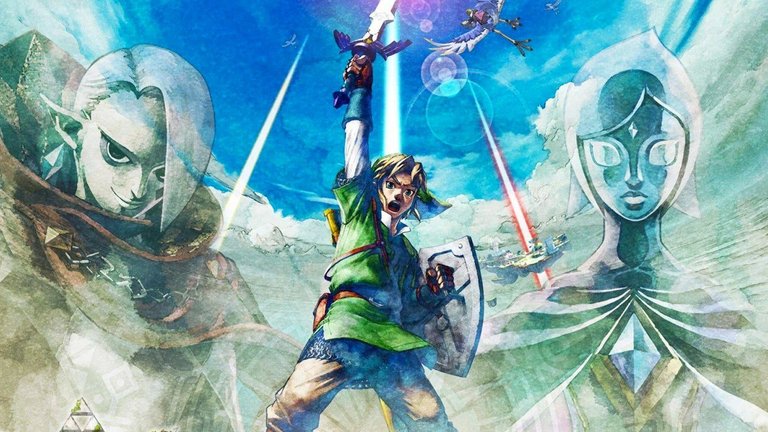

In terms of gameplay, everything we knew about a 3D Zelda remained more or less the same in terms of mobility, interaction, etc., the biggest change that Skyward Sword presented (and also the most controversial) respect to previous installments was the implementation of the Wii Motion Plus for the items usage and the sword combat. This time the movements of the sword will be "precise" according to our movement of the Wii Mote. I write precise in quotation marks because although this premise sounds attractive, the limitations of the Nintendo Wii hardware didn’t allow a correct optimization of the motion sensors, causing us to swing the sword in the wrong direction more than once.
The enemies have a more elaborate artificial intelligence that adapts to this new combat system. The idea of physically moving in order to play wasn’t accepted by many, as it was something that was completely out of what was a traditional scheme for a Zelda game, some found it uncomfortable, others annoying, there are even those who felt silly doing this. While I had some issues with aggressive battery consumption due to the Wii Motion Plus and some issues with proper motion detection, my overall experience was quite positive, I enjoyed the controls and I think those who say "you had to move too much" are exaggerating, the game is perfectly playable by just moving your hand or wrist in a normal way, or at least that was my experience.
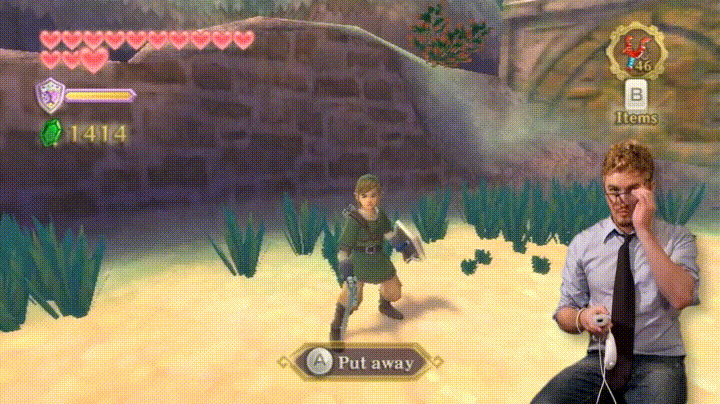
This new control scheme also allowed for the introduction of some pretty interesting items, my favorite one is the Beetle, a flying mechanical device that is controlled through the movement of the Wii Mote. When we use it, the view changes to the perspective of the Beetle as it moves in the direction we point it.
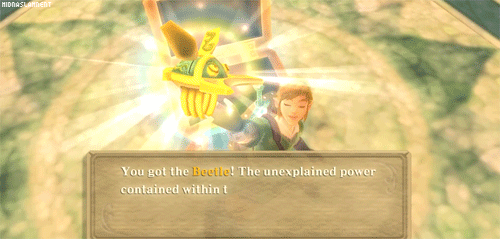
Another big change in this release is that the adventure no longer takes place neither in Hyrule, nor in the Great Sea, nor in the Twilight World, this time we find ourselves nothing more and nothing less than in the sky, it can be said that the game is divided into two segments: the sky and the lower lands. During our stay in the sky we will travel on the back of our faithful Loftwing, the Loftwing are giant colorful birds that the inhabitants of Sykloft use to soar through the skies. In the sky we have our main island, Skyloft, which functions as a sort of hub for the game and is where we will do most things. Unfortunately the rest of the sky is pretty big but pretty empty too, there's not too much to do apart from about two or three islands where we'll have some side activities and basically that's it. I think this is one the game’s biggest flaws and certainly the most wasted aspect, a sky as inhabited as the Great Sea of The Wind Waker would have been a great success.
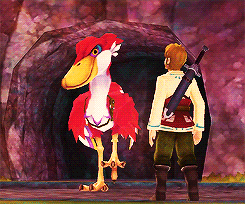
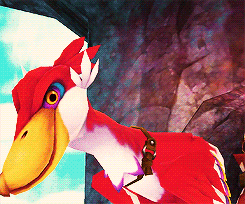
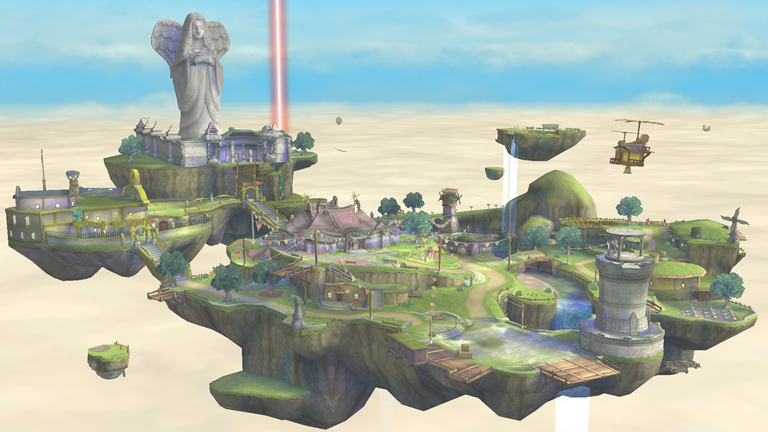
The lower lands are everything that is below the sky and it’s there that the story will have most of its development. We get there by jumping from the sky through an opening in the clouds. Here the world is divided into three sections: The Faron Woods, The Eldin Mountain, and the Lanayru Desert, each with its own gameplay dynamics and inhabited by a different race, it’s also in these places where we find the saga’s more than known dungeons that we have to complete in order to advance the plot, and its puzzles are quite interesting thanks to the control’s usage and more than one kept me thinking a while in its solution. A strong criticism that the game has is that we will have to visit each of these areas at least three times to finish the game, for many this is a problem, but the truth is that I liked that in each visit we did there were many different things, such as collecting the musical notes in the flooded with water Faron Woods. I thought it was an interesting proposal to keep fresh the fact of revisiting the same places several times.
Unlike other installments, exploration is quite limited and although the maps are quite large, they're also very linear and there aren't many paths that we can follow apart from the main path.
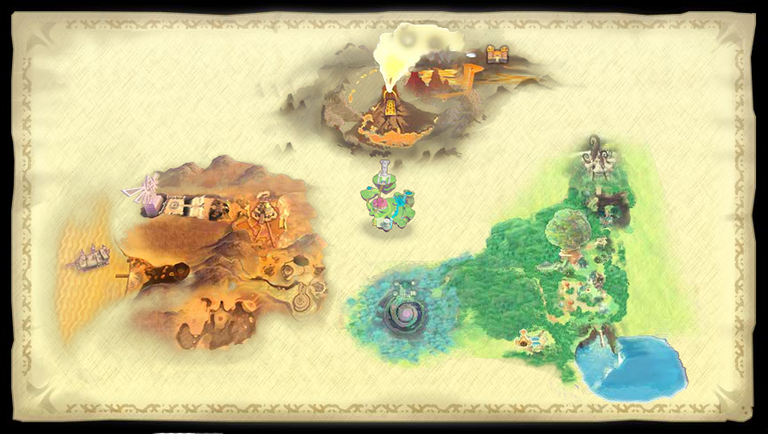
Another aspect that was strongly criticized was the way Fi was implemented. Fi is a spirit that dwells inside the sword of the heavens, the goddess Hylia created this spirit and placed it inside the sword in order to guide the chosen one once he appears. Just like Navi in Ocarina of Time or Midna in Twilight Princess, Fi is our companion and who will guide us along the way... The problem is that Fi takes you by the hand too much, constantly interrupts to say things that are obvious and doesn't let the player think or realize something on their own. It also doesn't help much that Fi's personality is shown as that of an emotionless robot so it's hard to empathize with her. However, to me, Fi didn't seem so terrible and in fact by the end of the game I ended up getting quite fond of her. But that's just my opinion.
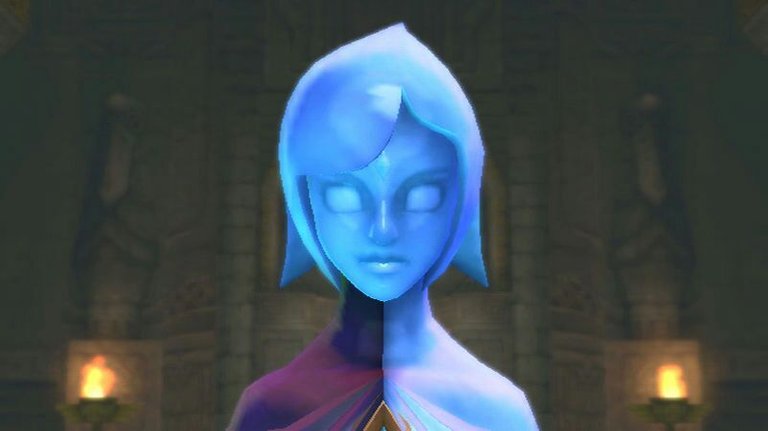

Something very special happens with the soundtrack this time, and it’s that this is the first the franchise has a completely live recorded by a symphony orchestra soundtrack. Every piece accompany every moment pretty nice and also are quite pleasant to listen to. The compositions are wonderful and a love letter to all fans of the franchise.

Undoubtedly the strongest point of this game is its story. One of the reasons why this game is so special to me is because of its story, this game is the first in the Zelda chronology and explains the origin of the Master Sword, the origin of Ganondorf, and the royal family of Hyrule.
The game begins with the story of a bloody war that took place in the lands below, in this war the forces of evil threatened to seize the Triforce, the legendary golden power that would give its bearer total power over the world. In order to keep evil away from the Triforce, with her power the goddess Hylia lifted a portion of the earth into the sky along with the survivors, thus creating the land of Skyloft. Meanwhile, in the lower lands, the goddess was able to weaken and seal the forces of evil, sacrificing herself in the process. After this introduction, it is shown how our protagonist, Link, is sleeping until his sleep is interrupted by Zelda’s Loftwing, who delivers him a letter to remind him that he has to attend the Celestial Tournament that takes place on the island of Skyloft.
After several events, Link and Zelda decide to go for a ride on their Loftwings across the sky and that's when a black tornado appears and absorbs Zelda. Link manages to save himself but Zelda's whereabouts are unknown, and at nightfall that day, Fi, a strange entity created by the goddess Hylia to guide the hero who will put an end to evil once and for all, appears before him, thus beginning the legend of Zelda. Without going into spoilers, this story is one of the best in the entire saga and it was undoubtedly a total success that this time Zelda is a childhood friend of Link and not a princess that we see once or twice throughout the game.
The early parts of the story help us to connect with the characters and make us really care about them, and later in the plot (especially towards the end) the narrative takes on an incredible weight as the first game in the chronology.
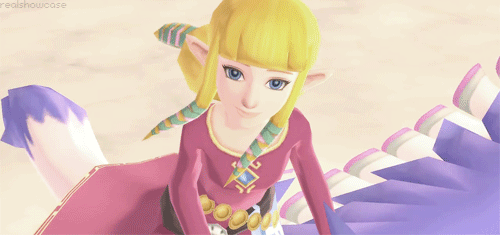

This game is very special to me because it was the first Zelda I played on my own and bought with my own money, by that time I was around 15 or 16 years old and I had a part time job that allowed me to save money in order to buy a Nintendo Wii and the game, the satisfaction of having it in my hands after so much hard work was something almost inexplicable. It was also released in commemoration of the 25th anniversary of the saga so it was an important event for the franchise, the edition I have has a music disc recorded by the Tokyo Philharmonic Orchestra and has a medley of all the important themes of the saga and two movements dedicated to The Wind Waker and Twilight Princess, overall the whole Skward Sword experience feels like a love letter to the franchise and the fans. I know that this installment sins of taking away a lot of freedom from the player in terms of exploration, but I like to see Skyward Sword as a game that decides to sacrifice the freedom of exploration so that the story it tells us is as clear as possible, it’s a game that wants to tell you a story and that's the wonderful thing about this franchise, that each game has something to offer to each person according to their tastes. Every second of Skyward Sword captivated me from beginning to end, for me it has the best characters of the entire saga and also the best story. It isn’t a perfect game at all and I don’t think it’s the best one in the saga objectively speaking, it fails in terms of control optimization and the overall pace of the game, as well as having made the sky so empty, but after all there is nothing written about tastes and what is important when playing a game, watching a movie, a series, reading a comic, etc., is what it leaves in us, is what it makes us feel and above all that we enjoy it.


Español | Spanish
¡Saludos, Hive! Hablar de The Legend of Zelda: Skyward Sword siempre resulta complicado o polémico debido a que es título sumamente divisivo en cuanto a opiniones, y la primera opinión polémica la daré yo: The Legend of Zelda: Skyward Sword es mi juego de Zelda favorito. Si, por encima de The Wind Waker, de Twilight Princess, de Majora’s Mask, de Breath of the Wild, incluso por encima de Ocarina of Time. Sin embargo, el hecho de que sea mi favorito no nubla mi criterio a la hora de hablar objetivamente acerca de sus aciertos y sus fallas.
Así que sin más preámbulos, ¡comencemos!


El desarrollo de Skyward Sword comenzó en el año 2006 casi inmediatamente después de la salida de Twilight Princess, esto debido a que el equipo sintió que no lograron llenar sus propias expectativas con respecto al juego que querían hacer. Como algo recurrente cuándo se trata de Zelda, la meta era hacer un juego que fuese tan (o más) memorable que The Legend of Zelda Ocarina of Time. Este fue también un proyecto que tuvo un presupuesto más alto de lo habitual para Nintendo. Se esperaba que el desarrollo tardara 3 años, pero debido a distintos problemas que este afronto (cambios de guion, en el arte, retrasos, etc) el desarrollo terminó en junio del 2011 y Skyward Sword salió al mercado para la Nintendo Wii en noviembre del mismo año.
El periférico Wii Motion Plus fue esencial para la creación de este juego ya que le daba a Nintendo la oportunidad de llevar el uso de la espada a un nuevo nivel, por lo que se decidió que uno de los puntos centrales del argumento de este juego fuese la Espada Maestra y la nueva manera de controlarla a través de un movimiento mucho más preciso, a diferencia en Twilight Princess en el que el movimiento era simplemente agitar el Wii Mote para golpear con la espada. El estilo artístico que tomo este juego creo que fue muy acertado, ya que se decidió algo que en líneas generales se puede definir como una combinación entre los estilos de The Wind Waker y Twilight Princess, inspirados en el arte impresionista que representaba muy bien un mundo de fantasía que al mismo tiempo le podía mantener una apariencia más madura para Link y los protagonistas.


En cuanto a lo jugable, todo lo que conocíamos de un Zelda en 3D se mantenía más o menos igual en cuanto a movilidad, interacción, etc, el mayor cambió que presentó Skyward Sword (y también el más polémico) respecto a las entregas anteriores fue la implementación del Wii Motion Plus para el uso de los objetos y principalmente el combate con espada. En esta oportunidad los movimientos de la espada serán “precisos” de acuerdo a nuestro movimiento del Wii Mote. Escribo preciso entre comillas porque si bien esta premisa suena atractiva, las limitaciones en el hardware del Nintendo Wii no permitían una correcta optimización de los sensores de movimiento, haciendo que más de una vez nos encontremos moviendo la espada en la dirección equivocada.
Los enemigos cuentan con una inteligencia artificial más elaborada que se adapta a este nuevo sistema de combate; ellos se cubrirán La idea de moverse para jugar no fue del agrado de muchos ya que era algo que se salía completamente de lo que era un esquema tradicional para un juego de Zelda, a algunos les resultaba incomodo, a otros molesto, hay quienes incluso se sentían tontos haciendo esto. Si bien yo tuve algunos problemas en cuanto al consumo agresivo de las baterías debido al Wii Motion Plus y algunos problemas de detección correcta del movimiento, mi experiencia general fue bastante positiva, yo disfruté los controles y creo que quienes dicen que “había que moverse demasiado” exageran, el juego es perfectamente jugable con solo mover la mano o la muñeca de forma normal, o al menos así fue mi experiencia.

Este nuevo esquema de control también permitió la introducción de objetos bastante interesantes, mi favorito de todos es el Escarabajo, un aparato mecánico volador que controlamos a través del movimiento del Wii Mote. Cuando lo usamos la vista cambia a la perspectiva del Escarabajo mientras se traslada hacia la dirección que lo dirijamos.

Otro gran cambio que hubo en esta entrega es que la aventura ya no toma lugar ni en Hyrule, ni el Gran Mar, ni el Mundo del Crepúsculo, esta vez nos encontramos nada más y nada menos que en el cielo, se puede decir que el juego se divide en dos segmentos: el cielo y las tierras inferiores. Durante nuestra estadía en el cielo viajaremos en el lomo de nuestro fiel Neburi, los Neburi son aves gigantes de colores que los habitantes de Neburia utilizan para trasladarse a través de los cielos. En el cielo tenemos nuestra isla principal, Neburia, que funciona como una especie de hub para el juego y es donde haremos la mayoría de cosas. Lamentablemente el resto del cielo es bastante grande pero bastante vacío también, no hay demasiado por hacer aparte de unas dos o tres islas donde tendremos unas actividades secundarias y básicamente eso es todo. Creo que este es uno de los mayores fallos del juego y sin duda el aspecto más desaprovechado, un cielo igual de habitado que el Gran Mar de The Wind Waker hubiese sido un gran acierto.



Las tierras inferiores son todo lo que está debajo del cielo y es allí donde la historia tendrá la mayor parte de su desarrollo. Llegamos allí saltando desde el cielo a través de unas aberturas que hay entre las nubes. Aquí el mundo se divide en tres secciones: El Bosque de Faron, Las Montañas de Eldin, y el Desierto de Lanayru, cada una con sus propias dinámicas de juego y habitada por una raza distinta, también es en estos lugares donde encontramos las ya más que conocidas mazmorras del juego que tendremos que completar para avanzar en la trama y sus puzzels son de lo más interesantes gracias nuevamente al uso del control y más de uno me mantuvo pensando un buen rato en su solución. Una fuerte crítica que tiene el juego es que tendremos que visitar cada una de estas áreas al menos tres veces para terminar el juego, y si bien para muchos esto es un problema la verdad es que a mí me gustó que en cada visita que hiciéramos hubieran muchas cosas distintas, como por ejemplo recolectar las notas musicales en el Bosque de Farone inundado de agua. Me pareció una propuesta interesante para mantener interesante el hecho de revisitar los mismos lugares varias veces.
A diferencia de otras entregas la exploración es bastante limitada y los mapas a pesar de que son grandes, también son lineales y no hay muchos caminos que podamos recorrer a parte del camino principal.

Otro de los aspectos fuertemente criticados fue la manera en que se implementó a Fay. Fay es un espíritu que habita dentro de la espada de los cielos, la diosa Hylia creo a este espíritu y lo colocó dentro de la espada para que guiara al elegido una vez que este apareciera. Así como Navi en Ocarina of Time o Midna en Twilight Princess, Fay es nuestra acompañante y quién nos guiará en el camino… El problema es que Fay te toma demasiado de la mano, interrumpe constantemente para decir cosas que son obvias y no deja que el jugador piense o se dé cuenta de algo por su propia cuenta. Tampoco ayuda mucho el hecho de que la personalidad de Fay es mostrada como la de un robot sin emociones por lo que es difícil empatizar con ella. Sin embargo, a mi Fay no me pareció tan terrible y de hecho para el final del juego le terminé agarrando bastante cariño. Pero esa es solo mi opinión.


En el apartado del sonido ocurre algo muy especial, y es que esta es la primera vez en la que la franquicia cuenta con un soundtrack completamente grabado por una orquesta sinfónica en vivo. Todas las piezas acompañan muy bien todo momento y son particularmente agradables de escuchar. Las composiciones son maravillosas y una carta de amor para todos los fans de la franquicia.

Sin lugar a dudas el punto más fuerte de este juego es su historia. Una de las razones por la que este juego es tan especial para mi es por su historia, este juego es el primero en la cronología de Zelda y nos explica el origen de la Espada Maestra, el origen de Ganondorf, y de la familia real de Hyrule.
El juego comienza con el relato de una cruenta guerra que tuvo lugar en las tierras inferiores, en esta guerra las fuerzas del mal amenazaban con apoderarse de la Trifuerza, el legendario poder dorado que le daría a su portador poder total sobre el mundo. Con el fin de alejar al mal de la Trifuerza, con su poder la diosa Hylia elevó una porción de la tierra al cielo junto a los sobrevivientes, creando así la tierra de Neburia. Mientras tanto, en las tierras inferiores, la diosa fue capaz de debilitar y sellar a las fuerzas del mal, sacrificándose en el proceso. Luego de esta introducción se muestra como nuestro protagonista, Link, se encuentra durmiendo hasta que su sueño es interrumpido por el Neburi de su amiga Zelda, quién le envía una carta para recordarle que tiene que asistir al Torneo Celeste que se lleva a cabo en la isla de Neburia.
Después de varios sucesos, Link y Zelda deciden ir de paseo sobre sus Neburi a través del cielo y ahí es cuando aparece un torbellino negro que absorbe a Zelda. Link logra salvarse pero el paradero de Zelda es desconocido, y al anochecer de ese día aparece ante el Fay, una extraña entidad creada por la diosa Hylia para guiar al héroe que pondrá fin al mal de una vez por todas, dando así inicio a la leyenda de Zelda. Sin entrar en spoilers, esta historia es una de las mejores de toda la saga y sin dudas fue un acierto total que se haya hecho que esta vez Zelda sea una amiga de la infancia de Link y no una princesa a la que vemos una o dos veces durante todo el juego.
Los primeros compases de la historia nos ayudan a conectar con los personajes y a hacer que realmente nos preocupemos por ellos, y más avanzada la trama (sobre todo hacia el final) la narrativa cobra un peso increíble como el primer juego en la cronología.


Este juego es muy especial para mi porque fue el primer Zelda que jugué por mi cuenta y comprado con mi propio dinero, ya para ese entonces tenía alrededor de 15 o 16 años y tenía un trabajo de medio tiempo que me permitió ahorrar dinero para un Nintendo Wii y el juego, la satisfacción de tenerlo en mis manos luego de tanto trabajo duro fue algo casi inexplicable. También fue lanzado en conmemoración del 25 aniversario de la saga por lo que fue un evento importante para la franquicia, la edición que yo tengo vino con un disco grabado por la Orquesta Filarmónica de Tokyo y tiene un medley de todos los temas importantes de la saga y dos movimientos dedicados a The Wind Waker y Twilight Princess, en general toda la experiencia de Skward Sword se siente como una carta de amor a la franquicia y a los fans. Sé que esta entrega peca de quitarle mucha libertad al jugador en cuanto a la exploración, pero me gusta ver a Skyward Sword como un juego que decide sacrificar la libertad de exploración para que la historia que nos cuenta sea lo más clara posible, es un juego que te quiere contar una historia y eso es lo maravilloso de esta franquicia, que cada juego tiene algo que ofrecerle a cada persona de acuerdo a sus gustos. Cada segundo de Skyward Sword me cautivó de principio a fin, a mi gusto tiene a los mejores personajes de toda la saga y también la mejor historia. No es para nada un juego perfecto y no creo tampoco que sea el mejor de la saga objetivamente hablando, falla en cuanto a la optimización del control y el ritmo general del juego, así como también en haber hecho el cielo tan vacío, pero después de todo de gustos no hay nada escrito y lo importante a la hora de jugar un juego, ver una película, una serie, leer un comic, etc, es lo que este deje en nosotros, es lo que nos haga sentir y sobretodo que lo disfrutemos.


Thank you! | !Gracias!
Without realizing it I'm almost at the end of the main line of The Legend of Zelda games, I just need to review Breath of the Wild and I'll be done with this series of reviews. It's been a great experience and I'm very happy that all the reviews have had so much support and positive comments, I want to thank all the people who have taken a few minutes of their valuable time to read my work, you motivate me to keep improving my way of writing and analyzing video games and above all to continue creating content for this amazing community, to all of you: Thank you!
Sin darme cuenta ya casi llego al final de los juegos de la línea principal de The Legend of Zelda, solo me falta el análisis de Breath of the Wild y habré terminado con esta serie de reseñas. Ha sido una experiencia genial y me alegra muchísimo que todas las reseñas hayan tenido tanto apoyo y comentarios positivos, quiero agradecer a todas las personas que se han tomado unos minutos de su valioso tiempo para leer mi trabajo, ustedes me motivan a seguir mejorando mi forma de escribir y analizar videojuegos y sobre todo a seguir creando contenido para esta increíble comunidad, a todos ustedes: ¡Gracias!
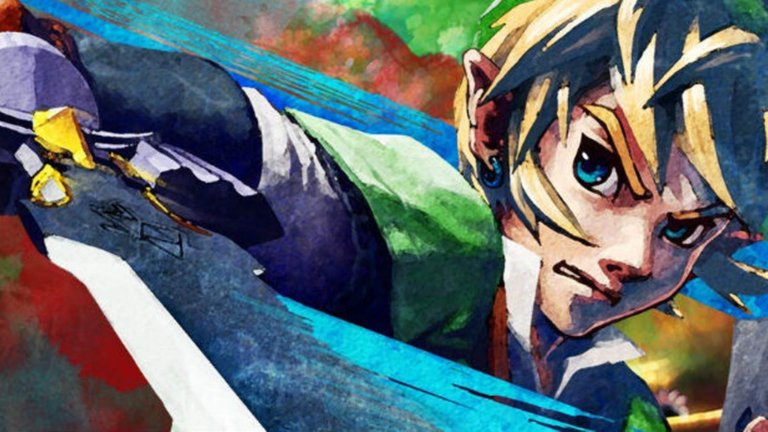
What about you? What do you think of Skyward Sword? Did its controls prevent you from enjoying it? Or did you decide to give it a chance anyway?
¿Y tu? ¿Qué opinas de Skyward Sword? ¿Sus controles te impidieron disfrutarlo o decidiste darle una oportunidad de todas maneras?

Thank you so much for reading me, see ya next post! | ¡Muchas gracias por leerme, nos vemos en el siguiente post!
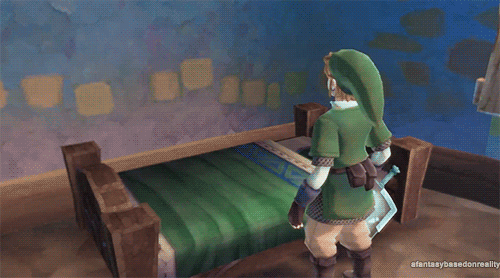
Previous reviews | Reseñas anteriores
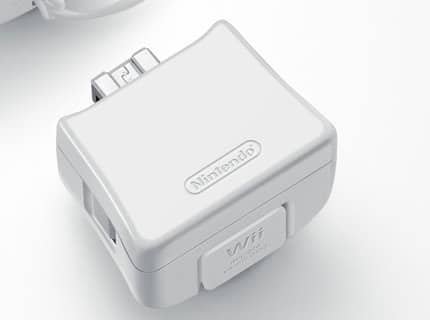

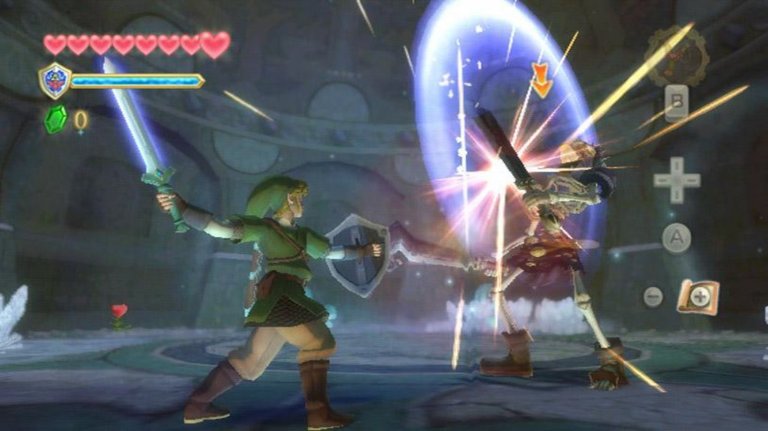
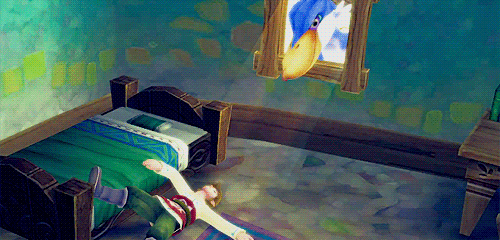
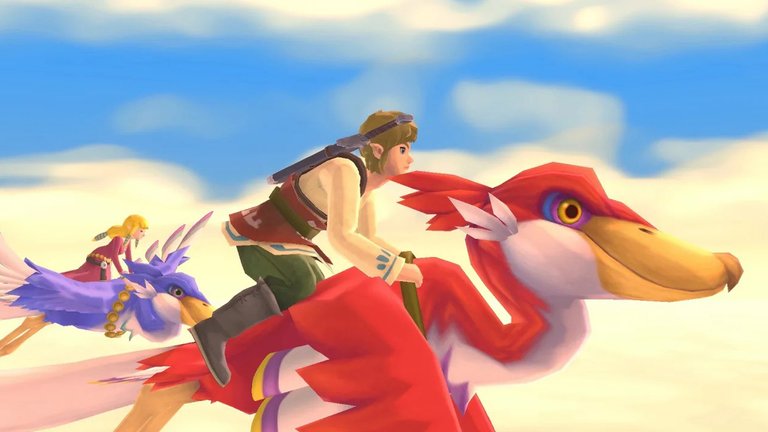
Congratulations @alejandroaldana! You have completed the following achievement on the Hive blockchain and have been rewarded with new badge(s) :
Your next target is to reach 400 upvotes.
You can view your badges on your board and compare yourself to others in the Ranking
If you no longer want to receive notifications, reply to this comment with the word
STOPCheck out the last post from @hivebuzz:
Este y The Wind Waker son los que tengo pendiente por jugar, tenía pensado jugar primero al Wind Waker pero con este post me pusiste en duda XD cuál me recomiendas probar primero? Buen post amigo
Creo que es indiferente cuál decidas jugar primero, cada uno es una experiencia distinta así puedes comenzar por el que más te llamé la atención :)
Muchas gracias bro!
I still don't understand the community's hatred for this game, I think it's very good at many things. Hopefully more people can appreciate it with its HD version.
It's cool that Nintendo is always trying to do new things and be creative. Motion controls are kind of annoying to me though, I am glad they moved away from that direction.
Since Skyward Sword gets a lot of bad reviews I have never played it. After hearing how much you like it maybe I'll give it a chance one day.
I have played it very little but it seemed to me a great game, the gameplay and the story, I was told that it is like the origin of all the Zeldas, I really do not know if it is true. I could not complete it because I bought the batteries of the controller and they lasted me only one day, I hope to have the opportunity to pass it to me. Very good post, I liked how you structured it.